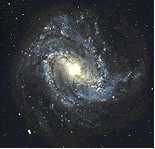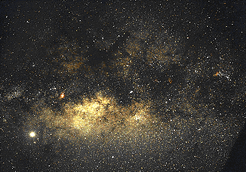An introduction
The Milky Way
Our own galaxy consists of about 200 billion stars, with our own Sun being a fairly typical specimen. It is a fairly large spiral galaxy and it has three main components: a disk, in which the solar system resides, a central bulge at the core, and an all-encompassing halo.

The spiral galaxy M83 is believed to be similar in size and shape to the Milky Way (AAO)
Disk:
The disk of the Milky Way has four spiral arms and it is approximately 300 parsecs thick (1 parsec is approximately 3.26 light years) and 30kpc in diameter. It is made up predominantly of Population I stars which tend to be blue and are reasonably young, spanning an age range between a million and ten billion years.
Bulge:
The bulge, at the centre of the galaxy, is a flattened spheroid of dimension 1kpc by 6kpc. This is a high density region where Population II stars predominate---stars which tend toward red and are very old, about 10 billion years. There is growing evidence for a very massive black hole at its centre.

A view of the Milky Way from the southern hemisphere - towards the centre of our galaxy (AAO)
Halo:
The halo, which is a diffuse spherical region, surrounds the disk. It has a low density of old stars mainly in globular clusters (these consist of between 10,000 - 1,000,000 stars). The halo is believed to be composed mainly of dark matter which may extend well beyond the edge of the disk.
The Milky Way is a spiral galaxy, which is just one of the many classification of galaxy, please click here to find out more about the various other classifications.
